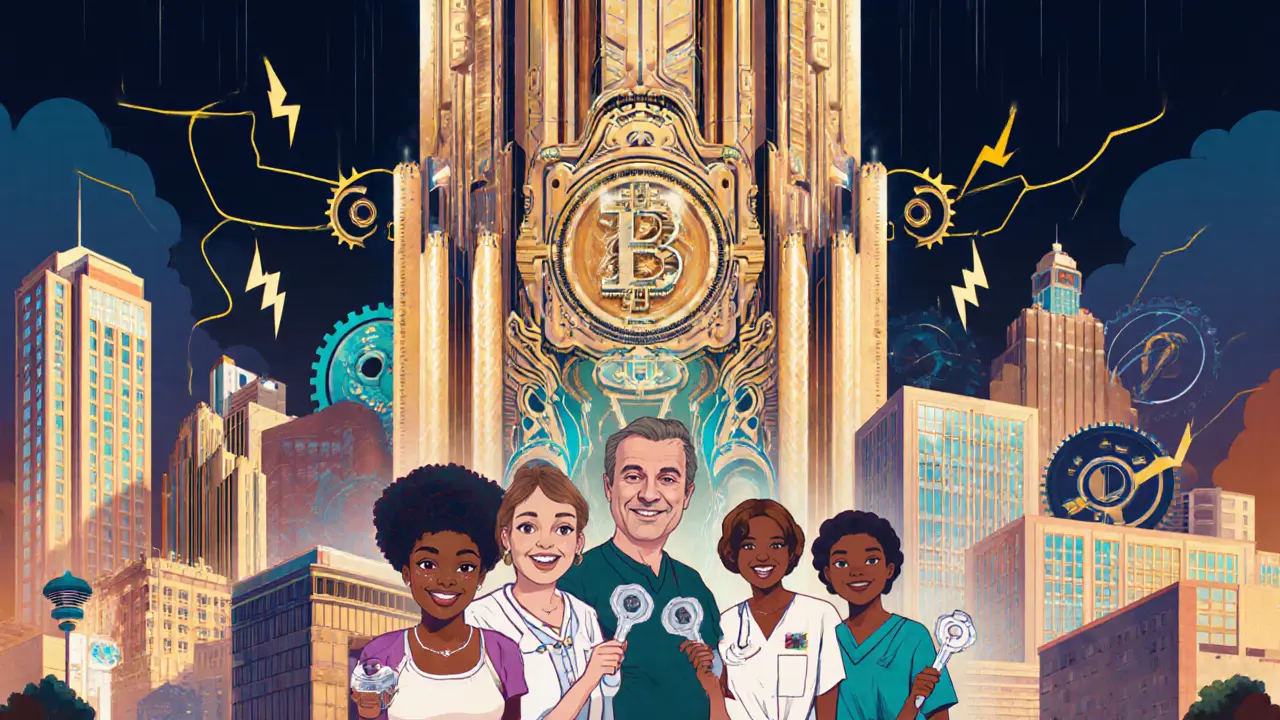Your Medical Data Access Control Simulator
See Your Data Control in Action
Simulate how blockchain gives you precise control over who sees your medical records. Test different sharing scenarios and see the difference in security and convenience.
Results: Traditional EHR vs. Blockchain
Your records are locked in the hospital's system
You must fill out forms to share records
Provider gets full access to all data
No way to revoke access after sharing
Your records are yours—stored securely off-chain
You grant access with a single tap
Provider sees only what you allow
Access automatically expires after set time
Imagine walking into an emergency room after a car crash, unconscious. Doctors need your allergy history, current medications, and past surgeries-but none of your records follow you. They’re stuck in a hospital system 50 miles away, locked behind incompatible software. This isn’t science fiction. It happens every day in the U.S. healthcare system. Now, picture a world where your medical history travels with you-secure, instantly accessible, and controlled only by you. That’s the promise of blockchain medical records.
How Blockchain Medical Records Actually Work
Blockchain isn’t just for Bitcoin. At its core, it’s a digital ledger that records transactions across many computers, making it nearly impossible to alter past entries. In healthcare, it doesn’t store your full medical file like a cloud server. Instead, it holds encrypted pointers or hashes-tiny digital fingerprints-that link to your real records stored elsewhere.
When your doctor updates your blood pressure reading, that change gets recorded as a new block on the chain. Each block is linked to the last, creating a permanent, tamper-proof timeline. Smart contracts-self-executing code on the blockchain-automatically control who can access what. For example, your cardiologist might get full access, while a physical therapist only sees your recent rehab notes. You decide who gets in, when, and for how long.
Systems like MeDShare and Patientory use Ethereum-based blockchains because they support these smart contracts. Some even use Soul-bound Tokens (SBTs), which are non-transferable digital IDs tied to your identity. These tokens can prove you’re the real patient without exposing your full medical history. If someone tries to fake your records, the blockchain instantly flags the mismatch.
Why This Beats Traditional Electronic Health Records
Today’s electronic health records (EHRs) are broken. A single hospital in Boston uses 26 different EHR systems. Each speaks a different language. Data doesn’t flow between them. Patients end up repeating tests, getting conflicting diagnoses, or worse-missing critical info because it’s buried in a system no one can access.
Blockchain fixes this by creating a single source of truth. No more pushing, pulling, or viewing records across incompatible platforms. Instead, you get one unified, patient-owned record that any authorized provider can pull up in seconds. That’s not theory-it’s already happening. Avaneer, backed by Aetna, CVS Health, and Cleveland Clinic, uses blockchain to streamline claims and verify provider credentials faster than ever before.
And the cost savings? Huge. About 25% of U.S. healthcare spending-hundreds of billions of dollars-is wasted on unnecessary tests, errors, and administrative bloat. With blockchain, redundant labs disappear. Medication errors drop. Treatment plans become more precise because doctors see the full picture.
Patients Gain Real Control Over Their Data
Right now, your medical records belong to the hospital, not you. You can request a copy, but it’s often a PDF you print and carry in a folder. With blockchain, you’re the owner. You grant or revoke access with a tap on your phone. Need to share your records with a new specialist? You send them a time-limited key. No more faxing, no more waiting weeks for a release form.
Patients using platforms like Patientory say they feel safer and more in charge. One user shared that after switching, she caught a medication error her old doctor missed-because her new provider could see her full history, including a rare reaction she’d had years ago. That kind of clarity saves lives.
SBTs take this further. They can verify you’re the patient without revealing your name or SSN. Imagine walking into a clinic and proving your identity and medical history in under 10 seconds-no ID card, no password, no paperwork. Just a secure digital handshake.

The Big Challenges: It’s Not Perfect Yet
Blockchain sounds ideal, but it’s not magic. There are real roadblocks.
First, scalability. Blockchains like Ethereum can get slow and expensive when thousands of hospitals are adding records every minute. Solutions like layer-2 networks and off-chain storage are being tested, but they’re still evolving.
Second, integration. Hospitals don’t just flip a switch. They’ve spent millions on EHR systems from vendors like Epic and Cerner. Getting those systems to talk to blockchain networks requires custom coding, testing, and staff training. Most health systems estimate 12 to 24 months just to pilot a basic blockchain integration.
Third, regulation. HIPAA requires strict privacy controls. But blockchain is immutable-once data is on it, you can’t delete it. That’s a conflict. Experts are working on solutions like storing only hashes on-chain and keeping full records off-chain with encryption. Still, regulators haven’t fully caught up.
Energy use is another concern. Early blockchains used massive amounts of electricity. Newer systems like Ethereum 2.0 use far less, but public perception lags. Many hospitals still assume blockchain = crypto = wasteful.
Who’s Already Using It? Real-World Examples
It’s not just hype. Companies are deploying this now.
ProCredEx uses blockchain to verify healthcare worker credentials. Before, hospitals spent months checking licenses and certifications manually. Now, it’s instant. If a nurse’s license expires, the system auto-flags it. No more fake credentials slipping through.
MeDShare tracks how patient data is used. If someone tries to access a record without permission, the system alerts the patient and revokes access automatically. It’s like having a security guard for your medical history.
IoMT devices-wearables, smart inhalers, glucose monitors-are now feeding encrypted data directly into blockchain nodes. A diabetic patient’s insulin usage, heart rate, and activity levels can be tracked in real time, shared with their doctor, and stored permanently. No more lost paper logs or forgotten app entries.
Even insurers are jumping in. By using blockchain to verify claims and treatments, they’ve cut fraud by up to 30% in pilot programs. That’s money saved-and passed on to patients.

What’s Next? The Road Ahead
Experts predict mainstream adoption in 5 to 7 years. That’s not far off. What’s holding us back isn’t the tech-it’s the people.
Doctors need training. IT teams need support. Patients need to understand how to use it. That’s why consortia like the Healthcare Blockchain Consortium are forming. They’re building standards so systems from different vendors can talk to each other.
Government pilots are starting too. The CDC and CMS are exploring blockchain for vaccine records and public health data. If it works for tracking flu shots, it can work for everything else.
AI is getting involved too. Machine learning can spot patterns in blockchain-stored data-like predicting a heart attack risk based on years of vitals. That’s the next frontier: not just storing records, but using them to prevent illness before it happens.
Final Thoughts: Is It Worth It?
Blockchain medical records won’t fix every problem in healthcare. But they solve the ones we’ve ignored for decades: fragmented data, lack of patient control, and insecure sharing.
The benefits-faster care, fewer errors, lower costs, and real privacy-are too big to ignore. The challenges are real, but they’re technical, not fundamental. They’re solvable with time, investment, and collaboration.
If you’re a patient, ask your doctor if they’re exploring blockchain. If you’re a provider, start testing. The future of healthcare isn’t just digital. It’s decentralized. And it’s coming faster than most think.
Can my medical records be hacked if they’re on blockchain?
Blockchain itself is extremely hard to hack because it’s distributed across thousands of computers. But the real risk isn’t the chain-it’s the endpoints. If someone steals your phone or tricks you into giving away your access key, they could view your records. That’s why strong encryption, multi-factor authentication, and user education are critical. The blockchain keeps the data tamper-proof; your device keeps it private.
Do I need a special device to use blockchain medical records?
No. You can access your records through a secure app on your smartphone or computer. Some systems even let you use a web portal. The blockchain runs in the background. You don’t need to understand how it works-just how to use the app. Think of it like using online banking: you don’t need to know how the bank’s servers work to check your balance.
Can I delete my records from the blockchain?
You can’t delete data from a blockchain-it’s designed to be permanent. But you don’t need to. Your actual medical data is stored securely off-chain. The blockchain only stores a reference or encrypted hash. If you revoke access, no one can see your records anymore. The data still exists, but it’s locked away. This meets HIPAA requirements for data control without violating blockchain’s immutability.
Is blockchain medical records expensive for hospitals to adopt?
Initial setup costs are high-typically hundreds of thousands to millions depending on size. But long-term, it saves money. One study found hospitals using blockchain reduced administrative costs by 30% and cut duplicate testing by nearly 40%. Insurance companies also save on fraud. For large health systems, the return on investment usually pays off in 2-3 years.
Will my insurance company see all my records if I use blockchain?
Only if you give them permission. Blockchain puts you in control. You decide who sees what. Your insurer might only get summary data for claims processing-like procedure codes and dates-not your full diagnosis history. You can even set time limits on access. This is a major shift from today’s system, where insurers often get full access by default.
How is this different from my current EHR portal?
Your current portal only shows records from one hospital or system. If you’ve been to three clinics, you have three separate logins. Blockchain links them all. You get one view of your complete history, no matter where you got care. Plus, you control sharing-not the hospital. If your doctor moves to a new system, your records come with you. No more losing your history when you switch providers.
Are there any privacy risks with Soul-bound Tokens (SBTs)?
SBTs are designed to protect privacy. They don’t store your medical data-they prove your identity. Think of them like a digital fingerprint that says, ‘This person has a valid medical history,’ without revealing what’s in it. Even if someone gets your SBT, they can’t access your records unless you grant permission. The real risk is if you lose your private key, but that’s true for any digital system. Recovery options are built into most platforms.
Can I use blockchain medical records if I don’t have a smartphone?
Yes. Many platforms offer web access or even phone-based access via secure voice or SMS codes. Some community clinics are even setting up kiosks where patients can authenticate with a PIN or biometric scan. The goal is accessibility-not just tech-savvy users. If you can use a website or make a phone call, you can use blockchain medical records.




Kevin Mann
November 5, 2025 AT 09:46Okay but like… imagine your grandma’s medical history is on a blockchain and she doesn’t know what a smartphone is 😭 She’s in the ER after falling, and the doctor’s like ‘Scan your QR code’ and she’s just holding her walker like ‘is this a virus??’ I’m not saying it’s bad-I’m saying we’re moving at the speed of light while half the population still thinks ‘cloud’ means rain. Also, can I get a blockchain tattoo? I’d wear it on my forehead.
Kathy Ruff
November 6, 2025 AT 10:49Blockchain for medical records is a huge step forward, but we can’t ignore the human factor. Many elderly and low-income patients don’t have reliable internet or digital literacy. If we roll this out without accessibility options, we’re creating a two-tier system where only the tech-savvy get safe, seamless care. The solution isn’t just tech-it’s education, outreach, and analog backups. We’re not building for a sci-fi future-we’re fixing real people’s lives today.
Robin Hilton
November 8, 2025 AT 02:35Blockchain? In AMERICA? Are you kidding me? We can’t even get a simple ID card system right. This is just another Silicon Valley fantasy. Meanwhile, real doctors are drowning in paperwork and Medicare red tape. You want to fix healthcare? Stop giving billionaires crypto dreams and start paying nurses a living wage. Also-why is everyone so obsessed with ‘decentralization’? My records should be safe, not trendy.
Grace Huegel
November 9, 2025 AT 22:06It’s fascinating, really-the way we fetishize technology as a panacea for systemic failure. Blockchain doesn’t address the root: profit-driven healthcare. A system that prioritizes billing over healing won’t be fixed by immutable ledgers. The real tragedy? We’re dazzled by the glitter of innovation while the patient’s dignity continues to erode. This isn’t progress. It’s distraction with a whitepaper.